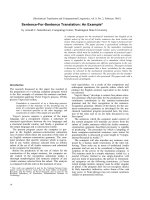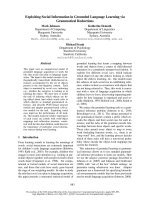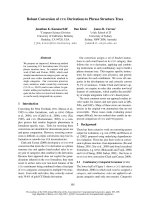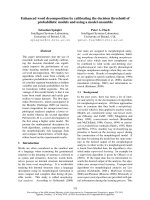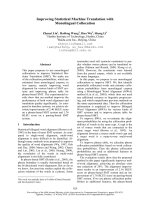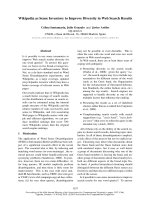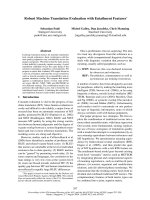Báo cáo khoa học: "Robust Word Sense Translation by EM Learning of Frame Semantics" docx
Bạn đang xem bản rút gọn của tài liệu. Xem và tải ngay bản đầy đủ của tài liệu tại đây (218.04 KB, 8 trang )
Proceedings of the COLING/ACL 2006 Main Conference Poster Sessions, pages 239–246,
Sydney, July 2006.
c
2006 Association for Computational Linguistics
Robust Word Sense Translation by EM Learning of Frame Semantics
Pascale Fung and Benfeng Chen
Human Language Technology Center
Department of Electrical & Electronic Engineering
University of Science & Technology (HKUST)
Clear Water Bay
Hong Kong
{pascale,bfchen}@ee.ust.hk
Abstract
We propose a robust method of auto-
matically constructing a bilingual word
sense dictionary from readily available
monolingual ontologies by using esti-
mation-maximization, without any an-
notated training data or manual tuning.
We demonstrate our method on the
English FrameNet and Chinese HowNet
structures. Owing to the robustness of
EM iterations in improving translation
likelihoods, our word sense translation
accuracies are very high, at 82% on av-
erage, for the 11 most ambiguous words
in the English FrameNet with 5 senses
or more. We also carried out a pilot
study on using this automatically gener-
ated bilingual word sense dictionary to
choose the best translation candidates
and show the first significant evidence
that frame semantics are useful for
translation disambiguation. Translation
disambiguation accuracy using frame
semantics is 75%, compared to 15% by
using dictionary glossing only. These
results demonstrate the great potential
for future application of bilingual frame
semantics to machine translation tasks.
1 Introduction
As early as in the 1950s, semantic nets were in-
vented as an “interlingua” for machine transla-
tion.
The “semantic net” or “semantic map” that
humans possess in the cognitive process is a
structure of concept classes and lexicon (Illes and
Francis 1999). In addition, the frame-semantic
representation of predicate-argument relations
has gained much attention in the research com-
munity. The Berkeley FrameNet (Baker et al.
1998) is such an example.
We suggest that in addition to dictionaries, bi-
lingual frame semantics (word sense dictionary)
is a useful resource for lexical selection in the
translation process of a statistical machine trans-
lation system. Manual inspection of the contras-
tive error analysis data from a state-of-the-art
SMT system showed that around 20% of the er-
ror sentences produced could have been avoided
if the correct predicate argument information was
used (Och et al. 2003). Therefore, frame seman-
tics can provide another layer of translation dis-
ambiguation in these systems.
We therefore propose to generate a bilingual
frame semantics mapping (word sense diction-
ary), simulating the “semantic map” in a bilin-
gual speaker. Other questions of interest to us
include how concept classes in English and Chi-
nese break down and map to each other.
This paper is organized as follows. In section
2, we present the one-frame-two-languages idea
of bilingual frame semantics representation. In
section 3, we explain the EM algorithm for gen-
erating a bilingual ontology fully automatically.
In section 4, we present an evaluation on word
sense translation. Section 5 describes an evalua-
tion on how well bilingual frame semantics can
improve translation disambiguation. We then
discuss related work in section 6, conclude in
section 7, and finally discuss future work in sec-
tion 8.
2 One Frame Two Languages
The challenge of translation disambiguation is to
select the target word cl* with the correct seman-
tic frame f (cl,f), among the multitude of transla-
tion candidates Pr(cl|el). We suggest that while a
source word in the input sentence might have
multiple translation candidates, the correct target
word must have the same sense, i.e., belong to
the same semantic frame, as the source word (i.e.
Pr(cl,f|el,f) is high). For example, “burn|
烫
239
(tang)” carries the “cause_harm|damage”
sense
, whereas “burn| 烧 (shao)” carries the
“heat|cooking” sense.
The source sentence “My
hands are burned” has the
“cause_harm|damage” sense, therefore the cor-
rect translation of “burn” is “
烫 (tang)” not
“烧(shao)”
. The frame semantics information
of the source word can thus lead to the best trans-
lation candidate.
Whereas some translation ambiguities are
preserved over languages, most are not. In par-
ticular, for languages as different as English and
Chinese, there is little overlap between how lexi-
con is broken-down (Ploux and Ji 2003). Some
cognitive scientists suggest that a bilingual
speaker tends to group concepts in a single se-
mantic map and simply attach different words in
English and Chinese to the categories in this
map.
Based on the above, we propose the one-
frame-two-languages idea for constructing a bi-
lingual word sense dictionary from monolingual
ontologies.
FrameNet (Baker et al. 1998) is a collection of
lexical entries grouped by frame semantics. Each
lexical entry represents an individual word sense,
and is associated with semantic roles and some
annotated sentences. Lexical entries with the
same semantic roles are grouped into a “frame”
and the semantic roles are called “frame ele-
ments”. Each frame in FrameNet is a concept
class and a single word sense belongs to only one
frame. However, the Chinese HowNet represents
a hierarchical view of lexical semantics in Chi-
nese.
HowNet (Dong and Dong 2000) is a Chinese
ontology with a graph structure of word senses
called “concepts”, and each concept contains 7
fields including lexical entries in Chinese, Eng-
lish gloss, POS tags for the word in Chinese and
English, and a definition of the concept including
its category and semantic relations (Dong and
Dong, 2000). Whereas HowNet concepts corre-
spond roughly to FrameNet lexical entries, its
semantic relations do not correspond directly to
FrameNet semantic roles.
A bilingual frame, as shown in Figure 1,
simulates the semantic system of a bilingual
speaker by having lexical items in two languages
attached to the frame.
3 Automatic Generation of Bilingual
Frame Semantics
To choose “burn|烫(tang)” instead of “burn|烧
(shao)”
in the translation of “My hands are
burned”, we need to know that “
烫(tang)”
belongs to the “cause_harm” frame, but “ 烧
(shao)”
belongs to the “heat” frame. In other
words, we need to have a bilingual frame seman-
tics ontology. Much like a dictionary, this bilin-
gual ontology forms part of the translation
“lexicon”, and can be used either by human
translators or automatic translation systems.
Such a bilingual frame semantics ontology
also provides a simulation of the “concept lexi-
con" of a bilingual person, as suggested by cog-
nitive scientists.
Figure 1 shows an example of a bilingual
frame that possibly corresponds to the semantic
structure in a bilingual person.
Figure 1. An example bilingual frame
We previously proposed using the Chinese
HowNet and a bilingual lexicon to map the Eng-
lish FrameNet into a bilingual BiFrameNet (Fung
and Chen 2004). We used a combination of
frame size thresholding and taxonomy distance
to obtain the final alignment between FrameNet
frames and HowNet categories, to generate the
BiFrameNet.
Our previous algorithm had the disadvantage
of requiring the ad hoc tuning of thresholds. This
results in poor performance on lexical entries
from small frames (i.e. frames with very few
lexical entries). The tuning process also means
that a development set of annotated data is
needed. In this paper, we propose a fully auto-
matic estimation-maximization algorithm in-
stead, to generate a similar FrameNet to HowNet
240
bilingual ontology, without requiring any anno-
tated data or manual tuning. As such, our method
can be applied to ontologies of any structure, and
is not restricted to FrameNet or HowNet.
Our approach is based on the following as-
sumptions:
1. A source semantic frame is mapped to a tar-
get semantic frame if many word senses in
the two frames translate to each other;
2. A source word sense translates into a target
word sense if their parent frames map to each
other.
The semantic frame in FrameNet is defined
as a single frame, whereas in HowNet it is de-
fined as the category. The formulae of our pro-
posed algorithm are listed in Figure 2.
Variable definitions:
cl : Chinese lexeme .
cf : Chinese frame.
(cl, cf) : the word sense entry in cf .
el : English lexeme .
ef : English frame.
(el, ef) : the word sense entry in ef .
(All variables are assumed to be independent of
each other.)
Model parameters:
Pr(cl|el): bilingual word pair probability from
dictionary
Pr(cf|ef): Chinese to English frame mapping
probability.
Pr(cl,cf|el,ef): Chinese to English word sense
translation probability.
(1) Word senses that belong to mapped frames
are translated to each other:
()
()
()
clcl
efelcfcl
efcfelcl
efelcfcl
cf
∀=
⋅
=
∑
∀
1)Pr(
y probabilit priori a theassume wewhere
,|,Pr
|Pr)|Pr(
,|,Pr
(2) Frames that have translated word senses
are mapped to each other:
∑∑∑
∑∑
∀∀∀
∀∀
=
cf el cl
el cl
efelcfcl
efelcfcl
efcf
),|,Pr(
),|,Pr(
)|Pr(
Figure 2. The bilingual frame semantics formulae
In the initialization step of our EM algorithm, all
English words in FrameNet are glossed into Chi-
nese using a bilingual lexicon with uniform
probabilities Pr(cl|el). Next, we apply the EM
algorithm to align FrameNet frames and HowNet
categories. By using EM, we improve the prob-
abilities of frame mapping in Pr(cf|ef) and word
sense translations in Pr(cl,cf|el,ef) iteratively: We
estimate sense translations based on uniform bi-
lingual dictionary probabilities Pr(cl|el) first.
The frame mappings are maximized by using the
estimated sense translation. The a priori lexical
probability Pr(cl) is assumed to be one for all
Chinese words. Underlining the correctness of
our algorithm, we note that the overall likeli-
hoods of the model parameters in our algorithm
improve until convergence after 11 iterations.
We use the alignment output after the conver-
gence step. That is, we obtain all word sense
translations and frame mapping from the EM
algorithm:
()
efefcfcf
efelefelcfclcfcl
cf
cfcl
∀=
∀
=
)|Pr(maxarg*
),( ,|,Prmaxarg)*,(
),(
The mapping between FrameNet frames and
HowNet categories is obviously not one-to-one
since the two languages are different. The initial
and final mappings before and after EM itera-
tions are shown in Figures 3a,b and 4a,b. Each
point (i,j) in Figures 3a and b represents an
alignment between FrameNet frame i to HowNet
category j. Before EM iterations, each English
lexical item is glossed into its (multiple) Chinese
translations by a bilingual dictionary. The parent
frame of the English lexical item and those of all
its Chinese translations are aligned to form an
initial mapping. This initial mapping shows that
each English FrameNet frame is aligned to an
average of 56 Chinese HowNet categories. This
mapping is clearly noisy. After EM iterations,
each English frame is aligned to 5 Chinese cate-
gories on average, and each Chinese category is
aligned to 1.58 English frames on average.
241
Figure 3a. FrameNet to HowNet mapping before EM
iterations.
Figure 3b. FrameNet to HowNet mapping after EM
iterations.
We also plot the histograms of one-to-X
mapping between FrameNet frames and HowNet
categories before and after EM iterations in Fig-
ure 4. The horizontal axis is the number X in
one-to-X mapping between English and Chinese
frames. The vertical axis is the occurrence fre-
quency. For example, point (i,j) represents that
there are j frames in English mapping to i catego-
ries in Chinese. Figure 4 shows that using lexical
glossing only, there are a large number of frames
that are aligned to over 150 of Chinese catego-
ries, while only a small number of English
frames align to relatively few Chinese categories.
After EM iterations, the majority of the English
frames align to only a few Chinese categories,
significantly improving the frame mapping
across the two languages.
Figure 4a. Histogram of one-to-X mappings between
English frames and Chinese categories. Most English
frames align to a lot of Chinese categories before EM
learning.
Figure 4b. Histograms of one-to-X mappings between
English frames and Chinese categories. Most English
frames only align to a few Chinese categories after
EM learning.
The above plots demonstrate the difference
between FrameNet and HowNet structures. For
example, “boy.n” belongs to “attention_getting”
and “people” frames in FrameNet.
“boy.n|attention_getting” should translate into “
茶房/waiter” in Chinese, whereas “boy.n|people”
has the sense of “
男孩/male child”. However,
in HowNet, both “
茶房/waiter” and “男孩/male
child” belong to the same category, human|
人.
burn.v,cause_harm > 辣.v,damage|损害
burn.v,cause_harm > 烫.v,damage|损害
burn.v,cause_harm > 嘘.v,damage|损害
burn.v,cause_harm > 蜇.v,damage|损害
burn.v,experience_bodily_harm > 烧
伤.v,wounded|受伤
burn.v,heat > 烧.v,cook|烹调
Figure 5. Example word sense translation of the
English verb “burn” in our bilingual frame se-
mantics mapping.
242
An example of word sense translation from our
algorithm output is shown in Figure 5. The word
sense translations of the FrameNet lexical entries
represent the simulated semantic world of a bi-
lingual person who uses the same semantic struc-
ture but with lexical access in two languages. For
example, the frame “cause_harm” now contains
the bilingual word sense pair
“
burn.v,cause_harm > 辣 .v,damage| 损 害 “;
and the frame “experience_bodily_harm” con-
tains the bilingual word sense pair
“
burn.v,experience_bodily_harm > 烧
伤.v,wounded|受伤”.
4 Robust Word Sense Translation Using
Frame Semantics
We evaluate the accuracy of word sense transla-
tion in our automatically generated bilingual on-
tology, by testing on the most ambiguous lexical
entries in FrameNet, i.e. words with the highest
number of frames. These words and some of
their sense translations are shown in Table 1 be-
low.
tie.n,clothing -> 襻.n,part|部件
tie.v,cause_confinement -> 拘束.v,restrain|制止
tie.v,cognitive_connection -> 联结.v,connect|连
接
make.n,type -> 性质.n,attribute|属性
make.v,building -> 建造.v,build|建造
make.v,causation -> 令.v,CauseToDo|使动
roll.v,body-movement -> 摇动.v,wave|摆动
roll.v,mass_motion -> 翻滚.v,roll|滚
roll.v,reshaping -> 卷.v,FormChange|形变
feel.n,sensation -> 手感.n,experience|感受
feel.v,perception_active -> 觉得.v,perception|感
知
feel.v,seeking -> 摸.v,LookFor|寻
Table 1. Example word sense translation out-
put
The word sense translation accuracies of the
above words are shown in Table 2. The results
are highly positive given that those from previ-
ous work in word translation disambiguation us-
ing bootstrapping methods (Li and Li, 2003;
Yarowsky 1995) achieved 80-90% accuracy in
disambiguating between only two senses per
word
1
.
The only susceptibility of our algorithm is in
its reliance on bilingual dictionaries. The sense
translations of the words “tie”, “roll”, and “look”
are relatively less accurate due to the absence of
certain translations in the dictionaries we used.
For example, the “bread/food” sense of the word
“roll” is not found in the bilingual dictionaries at
all.
English
word
Number of
frames/senses
in FrameNet
Sense
translation
accuracy
tie 8 64%
make 7 100%
roll 6 55%
feel 6 88%
can 5 81%
run 5 100%
shower 5 100%
burn 5 91%
pack 5 85%
drop 5 76%
look 5 64%
Average 5.6 82%
Table 2. Translation accuracies of the most am-
biguous words in FrameNet
We compare our results to that of our previ-
ous work (Fung and Chen 2004), by using the
same bilingual lexicon. Table 3 shows that we
have improved the accuracy of word sense trans-
lation using the current method.
lexical
entry
Parent frame Accuracy
(Fung &
Chen
2004)
Accuracy
(this pa-
per)
beat.v cause_harm 88.9%
100%
move.v motion 100%
100%
bright.a light_emission 79.1%
100%
hold.v containing 22.4%
100%
fall.v mo-
tion_directional
87%
100%
issue.v emanating 31.1%
100%
Table 3. Our method improves word sense
translation precision over Fung and Chen (2004).
We note in particular that whereas the previ-
ous algorithm in Fung and Chen (2004) does not
1
We are not able to evaluate our algorithm on the same
set of words as in (Li & Li 2003; Yarowsky 1995) since
these words do not have entries in FrameNet.
243
perform well on lexical entries from small frames
(e.g. on “hold.v” and “issue.v”) due to ad hoc
manual thresholding, the current method is fully
automatic and therefore more robust. In Fung
and Chen (2004), semantic frames are mapped to
each other if their lexical entries translate to each
other above a certain threshold. If the frames are
small and therefore do not contain many lexical
entries, then these frames might not be correctly
mapped. If the parent concept classes are not cor-
rectly mapped, then word sense translation accu-
racy suffers.
The main advantage of our algorithm over our
work in 2004 lies in the hill-climbing iterations
of the EM algorithm. In the proposed algorithm,
all concept classes are mapped with a certain
probability, so no mapping is filtered out prema-
turely. As the algorithm iterates, it is more prob-
able for the correct bilingual word sense to be
translated to each other, and it is also more prob-
able for the bilingual concept classes to be
mapped to each other. After convergence of the
algorithm, the output probabilities are optimal
and the translation results are more accurate.
5 Towards Translation Disambiguation
using Frame Semantics
As translation disambiguation forms the core of
various machine translation strategies, we are
interested in studying whether the generated bi-
lingual frame semantics can complement existing
resources, such as bilingual dictionaries, for
translation disambiguation.
The semantic frame of the predicate verb and
the argument structures in a sentence can be
identified by the syntactic structure, part-of-
speech tags, head word, and other features in the
sentence. The predicate verb translation corre-
sponds to the word sense translation we de-
scribed in the previous sections, Pr(cl,cf | el,ef).
We intend to evaluate the effectiveness of bi-
lingual frame semantics mapping in disambiguat-
ing between translation candidates. For the
evaluation set, we use 202 randomly selected
example sentences from FrameNet, which have
been annotated with predicate-argument struc-
tures.
In the first step of the experiment, for each
predicate word (el,ef), we find all its translation
candidates of the predicate word in each sen-
tence, and annotate them with their HowNet
categories to form a translated word sense
Pr(cl,cf|el,ef). For the example sentence in Fig-
ure 6, there are altogether 147 word sense trans-
lations for (hold,detaining).
Under South African law police could HOLD the man
for questioning for up to 48 hours before seeking the
permission of magistrates for an extension
##HOLD,detaining
# 召开,engage|从事
# 牵,guide|引导
# 以为,regard|认为
# 束缚,restrain|制止
# 装,load|装载
# 装,pretend|假装
# 手持,hold|拿
…
# 拿,hold|拿
# 拿,occupy|占领
# 握住,hold|拿
# 占,occupy|占领
…
# 持,hold|拿
# 握,hold|拿
…
# 操,hold|拿
# 操,speak|说
# 承,KeepOn|使继续
…
# 开,function|活动
# 开,manage|管理
# 扣留,detain|扣住 ++
# 要塞,facilities|设施
# 拥有,own|有 –
Figure 6. A FrameNet example sentence and predicate verb
translations {Pr(cl,cf|el,ef)}.
We then find the word sense translation with
the highest probability among all HowNet and
FrameNet class mappings from our EM algo-
rithm:
(
)
()
()
∑
∀
⋅
=
=
cf
cl
cl
efelcfcl
efcfelcl
efelcfclcl
,|,Pr
|Pr)|Pr(
maxarg
,|,Prmaxarg
*
An example (el,ef) is (hold, detaining) and the
cl*=argmax P(cl,cf|el,ef) found by our program
is
扣留
. (cl,cf)* in this case is (
扣留
,detain|
扣住
).
Human evaluators then look at the set of {cl*}
and mark cl* as either true translations or erro-
neous. The accuracy of word sense translations
on this evaluation set of example sentences is at
74.9%.
In comparison, we also look at Pr(cl|el), trans-
lation based on bilingual dictionary only, and
find
244
()
(
)
elclelclcl
clcl
,Prmaxarg|Prmaxarg
*
==
The translation accuracy of using bilingual
dictionary only, is at a predictable low 15.8%.
Our results are the first significant evidence
of, in addition to bilingual dictionaries, bilingual
frame semantics is a useful resource for the
translation disambiguation task.
6 Related Work
The most relevant previous works include word
sense translation and translation disambiguation
(Li & Li 2003; Cao & Li 2002; Koehn and
Knight 2000; Kikui 1999; Fung et al., 1999),
frame semantic induction (Green et al., 2004;
Fung & Chen 2004), and bilingual semantic
mapping (Fung & Chen 2004; Huang et al. 2004;
Ploux & Ji, 2003, Ngai et al., 2002; Palmer &
Wu 1995). Other than the English FrameNet
(Baker et al, 1998), we also note the construction
of the Spanish FrameNet (Subirats & Petruck,
2003), the Japanese FrameNet (Ikeda 1998), and
the German FrameNet (Boas, 2002). In terms of
learning method, Chen and Palmer (2004) also
used EM learning to cluster Chinese verb senses.
Word Sense Translation
Previous word sense translation methods are
based on using context information to improve
translation. These methods look at the context
words and discourse surrounding the source
word and use methods ranging from boostrap-
ping (Li & Li 2003), EM iterations (Cao and Li,
2002; Koehn and Knight 2000), and the cohe-
sive relation between the source sentence and
translation candidates (Fung et al. 1999; Kikui
1999).
Our proposed translation disambiguation
method compares favorably to (Li & Li 2003) in
that we obtain an average of 82% precision on
words with multiple senses, whereas they ob-
tained precisions of 80-90% on words with two
senses. Our results also compare favorably to
(Fung et al. 1999; Kikui 1999) as the precision of
our predicate verb in the input sentence transla-
tion disambiguation is about 75% whereas their
precisions range from 40% to 80%, albeit on an
independent set of words.
Automatic Generation of Frame Semantics
Green et al. (2004) induced SemFrame automati-
cally and compared it favorably to the hand-
constructed FrameNet (83.2% precision in cover-
ing the FrameNet frames). They map WordNet
and LDOCE, two semantic resources, to obtain
SemFrame. Burchardt et al. (2005) used Frame-
Net in combination with WordNet to extend cov-
erage.
Bilingual Semantic Mapping
Ploux and Ji, (2003) proposed a spatial model for
matching semantic values between French and
English. Palmer and Wu (1995) studied the map-
ping of change-of-state English verbs to Chinese.
Dorr et al. (2002) described a technique for the
construction of a Chinese-English verb lexicon
based on HowNet and the English LCS Verb Da-
tabase (LVD). They created links between
HowNet concepts and LVD verb classes using
both statistics and a manually constructed “seed
mapping” of thematic classes between HowNet
and LVD. Ngai et al. (2002) induced bilingual
semantic network from WordNet and HowNet.
They used lexical neighborhood information in a
word-vector based approach to create the align-
ment between WordNet and HowNet classes
without any manual annotation.
7 Conclusion
Based on the one-frame-two-languages idea,
which stems from the hypothesis of the mind of a
bilingual speaker, we propose automatically gen-
erating a bilingual word sense dictionary or on-
tology. The bilingual ontology is generated from
iteratively estimating and maximizing the prob-
ability of a word translation given frame map-
ping, and that of frame mapping given word
translations. We have shown that for the most
ambiguous 11 words in the English FrameNet,
the average word sense translation accuracy is
82%. Applying the bilingual ontology mapping
to translation disambiguation of predicate verbs
in another evaluation, the accuracy of our
method is at an encouraging 75%, significantly
better than the 15% accuracy of using bilingual
dictionary only. Most importantly, we have dem-
onstrated that bilingual frame semantics is poten-
tially useful for cross-lingual retrieval, machine-
aided and machine translation.
8 Future Work
Our evaluation exercise has shown the promise
of using bilingual frame semantics for translation
task. We are currently carrying out further work
in the aspects of (1) improving the accuracy of
source word frame identification and (2) incorpo-
rating bilingual frame semantics in a full fledged
245
machine translation system. In addition, Frame-
Net has a relatively poor coverage of lexical en-
tries. It would be necessary to apply either semi-
automatic or automatic methods such as those in
(Burchardt et al. 2005, Green et al 2004) to ex-
tend FrameNet coverage for final application to
machine translation tasks. Last but not the least,
we are interested in applying our method to other
ontologies such as the one used for the Propbank
data, as well as to other language pairs.
Acknowledgement
This work was partially supported by CERG#
HKUST6206/03E and CERG# HKUST6213/02E
of the Hong Kong Research Grants Council. We
thank Yang, Yongsheng for his help in the final
draft of the paper, and the anonymous reviewers
for their useful comments.
References
Collin F. Baker, Charles J. Fillmore and John B.
Lowe. (1998).The Berkeley FrameNet project.
In Proceedings of the COLING-ACL, Montreal,
Canada.
Hans C. Boas. (2002). Bilingual FrameNet Diction-
aries for Machine Translation. In Proceedings of
the Third International Conference on Language
Resources and Evaluation. Las Palmas, Spain.
Vol. IV: 1364-1371 2002.
A. Burchardt, K. Erk, A. Frank. (2005). A WordNet
Detour to FrameNet. In
Proceedings of the 2nd GermaNet Workshop,
2005.
Cao, Yunbo and Hang Li. (2002). Base Noun
Phrase Translation Using Web Data and the EM
Algorithm. In COLING 2002. Taipei, 2002.
Jinying Chen and Martha Palmer. (2004). Chinese
Verb Sense Discrimination Using EM Clustering
Model with Rich Linguistic Features. In ACL
2004. Barcelona, Spain, 2004.
Dong, Zhendong., and Dong, Qiang. (2002)
HowNet [online]. Available at
/>ml
Bonnie J. Dorr, Gina-Anne Levow, and Dekang
Lin.(2002).Construction of a Chinese-English
Verb Lexicon for Machine Translation. In Ma-
chine Translation, Special Issue on Embedded
MT, 17:1-2.
Pascale Fung and Benfeng Chen. (2004). BiFra-
meNet: Bilingual Frame Semantics Resource
Construction by Cross-lingual Induction. In
COLING 2004. Geneva, Switzerland. August
2004.
Pascale Fung, Liu, Xiaohu, and Cheung, Chi Shun.
(1999). Mixed-Language Query Disambiguation.
In Proceedings of ACL ‘99, Maryland: June
1999.
Daniel Gildea and Daniel Juraf-
sky.(2002).Automatic Labeling of Semantic
Roles. In Computational Linguistics, Vol 28.3:
245-288.
Rebecca Green, Bonnie Dorr, Philip Resnik.
(2004). Inducing Frame Semantic Verb Classes
from WordNet and LDOCE. In ACL 2004.
François Grosjean in Lesley Milroy and Pieter
Muysken (editors). One Speaker, Two Lan-
guages. Cambridge University Press, 1995.
Chu-Ren Huang, Ru-Yng Chang, Hsiang-Pin Lee.
(2004).Sinica BOW (Bilingual Ontological
Wordnet): Integration of Bilingual WordNet and
SUMO. In Proceedings of the 4th International
Conference on
Language Resources and Evaluation, (2004).
Judy Illes and Wendy S. Francis. (1999). Conver-
gent cortical representation of semantic process-
ing in bilinguals. In Brain and Language,
70(3):347-363, 1999.
Satoko Ikeda. (1998). Manual response set in a
stroop-like task involving categorization of Eng-
lish and Japanese words indicates a common
semantic representation. In Perceptual and Mo-
tor Skills, 87(2):467-474, 1998.
Liu Qun and Li, Sujian. (2002). Word Similarity
Computing Based on How-net. In Computa-
tional Linguistics and Chinese Language Proc-
essing,Vol.7, No.2, August 2002, pp.59-76
Philipp Koehn and Kevin Knight. (2000). Estimat-
ing Word Translation Probabilities from Unre-
lated Monolingual Corpora Using the EM
Algorithm. In AAAI/IAAI 2000: 711-715
Grace Ngai, Marine Carpuat, and Pascale Fung.
(2002). Identifying Concepts Across Languages:
A First Step towards a Corpus-based Approach
to Automatic Ontology Alignment. In Proceed-
ings of COLING-02, Taipei, Taiwan.
Franz Och et al. (2003).
/>/
Martha Palmer and Wu Zhibiao. (1995).Verb Se-
mantics for English-Chinese Translation. In Ma-
chine Translation 10: 59-92, 1995.
Sabine Ploux and Hyungsuk Ji. (2003). A Model
for Matching Semantic Maps between Lan-
guages (French/English, English/French). In
Computational Linguistics 29(2):155-178, 2003.
Carlos Subitrats and Miriam Petriuck. (2003). Su-
prirse: Spanish FrameNet. Workshop on Frame
Semantics, International Congress of Linguists,
July 2003.
246

